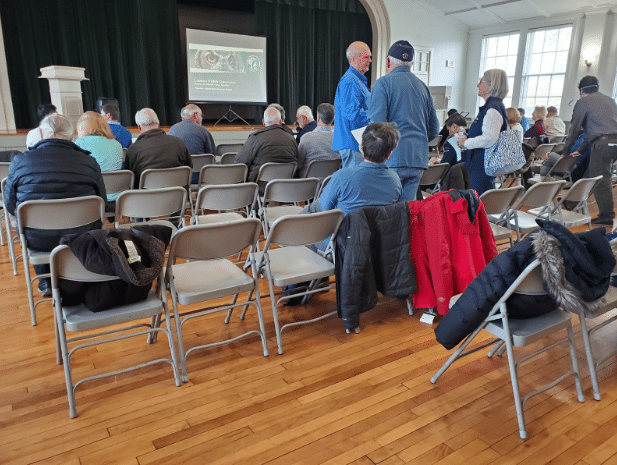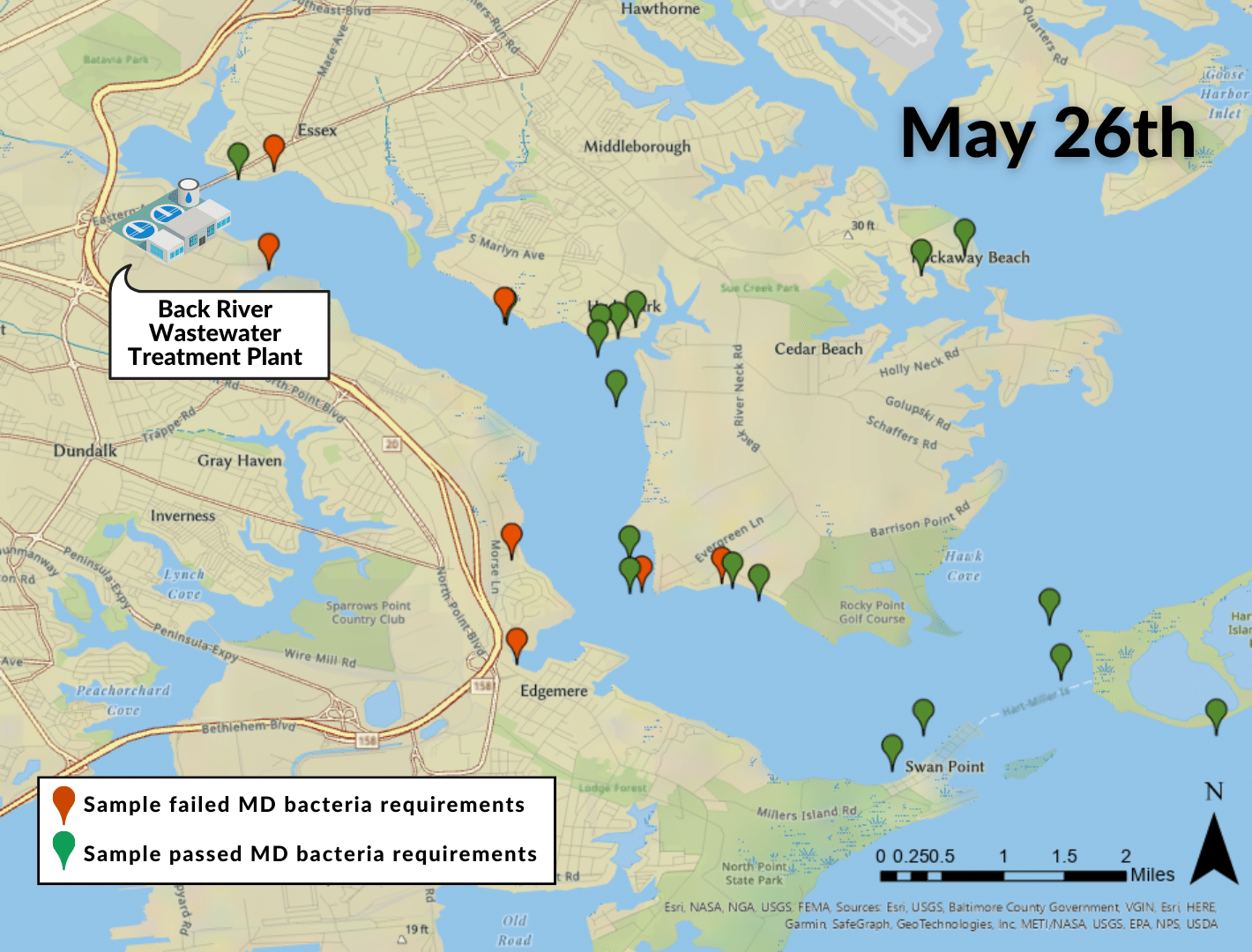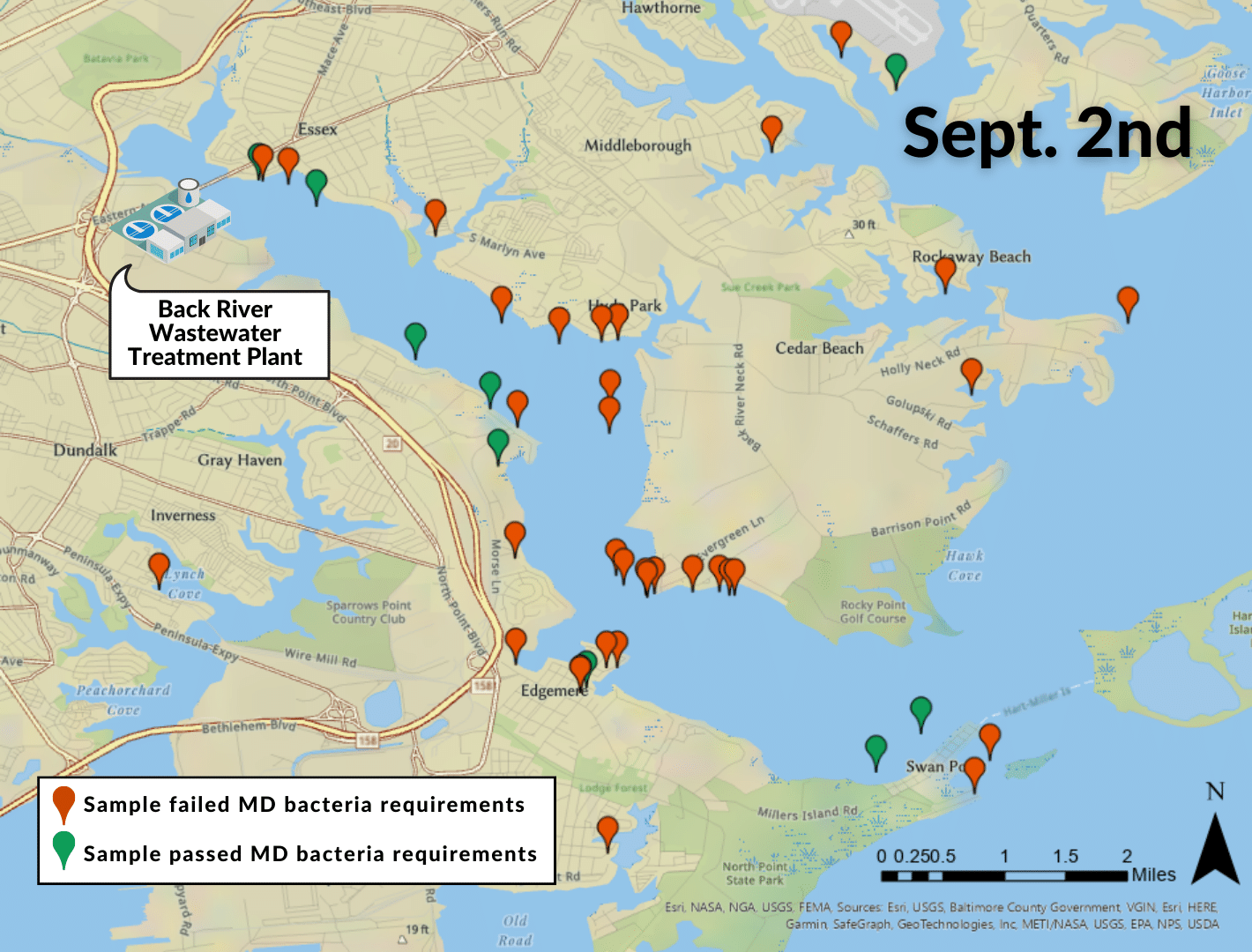CMC Case Studies
Stories from Around the Chesapeake
The case studies on the map below showcase the success of our volunteer monitors, whose efforts have made a tangible impact on the water quality of the Chesapeake Bay watershed. These stories demonstrate the power of community science and the positive impact that volunteers can have on their environment. By sharing these stories, we hope to inspire others to join the CMC in our mission to monitor and preserve the waterways in the Chesapeake Bay for future generations.

Written by: Matthew Kierce
Water Quality Monitoring Informs Public Safety Initiative
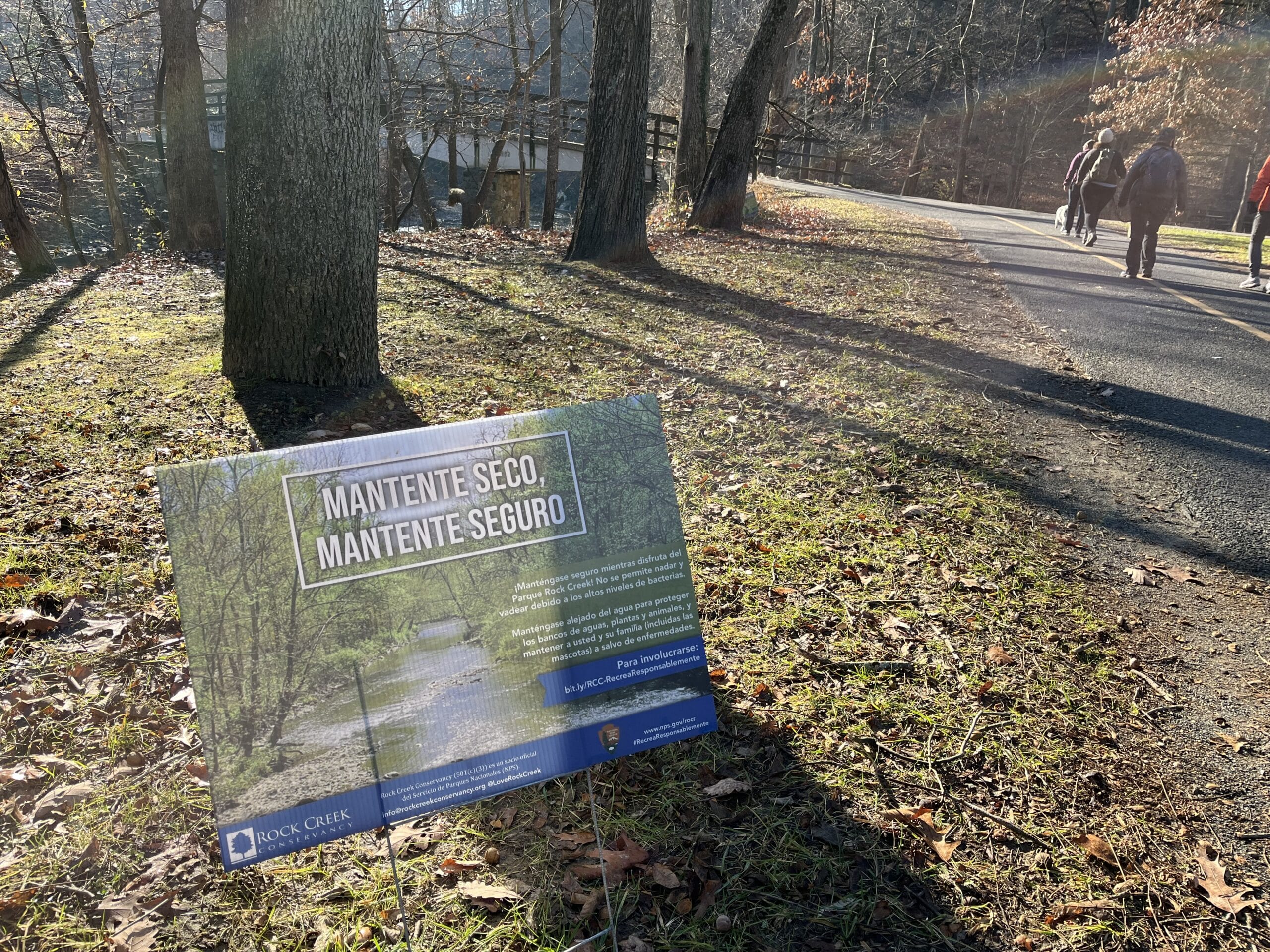
“Stay Dry, Stay Safe.”
Rock Creek Park, an expansive 2,749-acre urban sanctuary nestled in the heart of Washington, D.C., stands as a testament to natural preservation amidst urban development. Established in 1890 and managed by the National Park Service, the park offers a myriad of recreational opportunities, including 32 miles of trails, historic sites of cultural significance, and picnic areas, attracting over 2 million visitors annually. Central to the park’s natural allure is Rock Creek, a vital tributary of the Potomac River, which has been off-limits for contact recreation since 1971 due to water quality concerns.
The unforeseen circumstances of 2020, marked by the global pandemic, led to a significant surge in park visitation. With public swimming pools and recreational facilities closed, many sought respite from the summer heat in Rock Creek’s inviting waters, despite the longstanding prohibitions and the potential health risks due to water quality issues. Observations from National Park Service rangers at Rock Creek Park, coupled with data from the DC Citizen Science Water Quality Monitoring program, highlighted a marked increase in water-based recreational activities within the park.
In 2018, the DC Citizen Science Water Quality Monitoring Program was started through an award from the Department of Energy and Environment (DOEE), in response to the ongoing challenges of maintaining water quality within DC’s urban watershed. This program is currently coordinated by the Alliance for the Chesapeake Bay in partnership with Anacostia Riverkeeper, Rock Creek Conservancy, and Nature Forward, and monitors for bacteria, turbidity, pH, temperature, and recreational activity observations weekly throughout the summer in order to provide up-to-date information about the safety of the water near popular recreation sites along the Potomac River, Anacostia River, and Rock Creek. Data collected indicated that Rock Creek’s water quality met the established bacteria standards only half the time, and consistently failed following rainfall events.
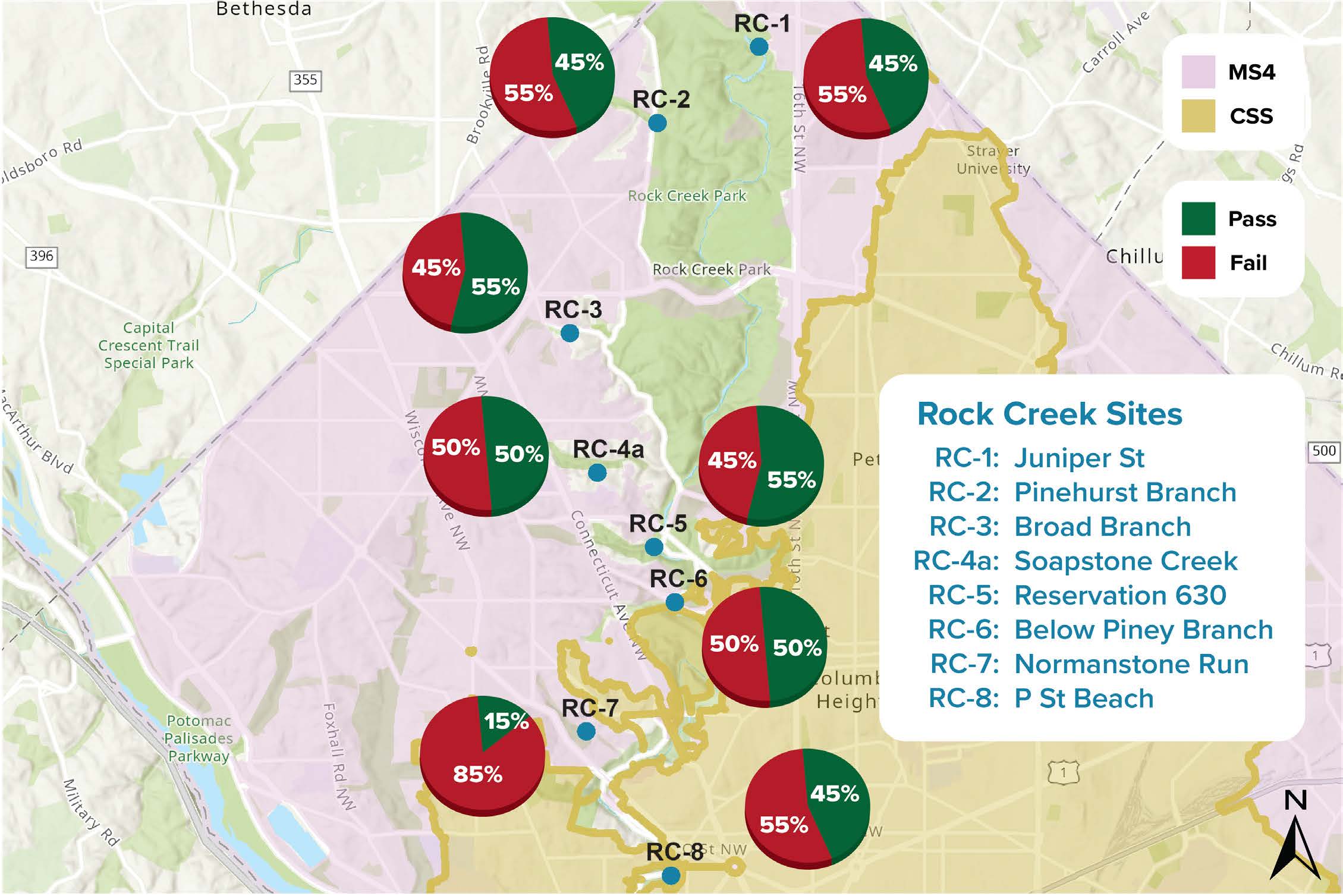
Graphics shows percent passing for E. coli single sample value (SSV).
Given the known water quality issues coupled with monitoring data and an observed increase in recreation in the area, the need for proactive public engagement and education became evident. In a concerted effort to address this challenge, Rock Creek Conservancy, in partnership with the National Park Service, embarked on a strategic initiative to enhance public awareness and promote safe park usage. A cornerstone of this initiative was the development and deployment of educational signage throughout the park. Four distinct signs were created, each addressing a specific issue identified by park rangers, ranging from loose dogs and improper use of hammocks to the critical message of avoiding water-based activities in Rock Creek. The “Stay Dry, Stay Safe” sign played a pivotal role in communicating the risks associated with entering the water, emphasizing with positive messages the potential for high bacterial levels that could pose health hazards to both humans and pets.
These signs, designed and funded by Rock Creek Conservancy, were strategically placed in high-traffic areas and near popular picnic spots adjacent to Rock Creek. The bilingual signage, available in English and Spanish to reflect the linguistic diversity of the DC community, was launched as part of the broader #RecreateResponsibly campaign, aimed at mitigating the environmental impact of increased park visitation.
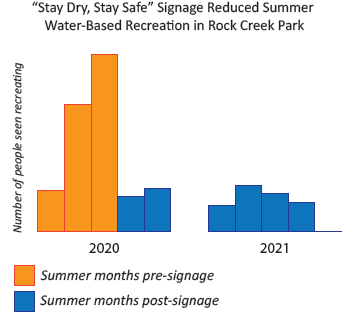
The impact of this signage initiative was profound and immediate. Following the installation of the signs in July, there was an 80% reduction in water-based recreational activities within several weeks. This trend continued, with a 67% decrease in such activities over the following summer and a staggering 90% reduction by 2023. The success of this initiative underscores the effectiveness of targeted community engagement and educational efforts in fostering responsible park usage and environmental stewardship.
Looking ahead, Rock Creek Conservancy, buoyed by the positive outcomes of the signage initiative, plans to continue to provide signs to the National Park Service and to consider novel ways to address more challenging issues. Data can be hard to convey to the public, however, it is vital that communities and scientists work together to provide crucial information from these dataset to the public. This means providing information in a format and language they can easily understand and placing the information where it is most important to read. It is clear that initiatives as simple as collaborating with groups around a watershed, and creating and displaying public signage, can make a large impact.

Written by: Maria Burke
Monitoring Discovery Leads to Improved Wastewater Management
Blue Water Baltimore (BWB) is a non-profit organization established in 2010 from five watershed associations which joined together. BWB is dedicated to ensuring that Baltimore’s waterways are healthy, safe, and clean. They accomplish this through monitoring water quality, planting trees, education, and advocacy. They began monitoring water quality in 2010, which occurs at 49 stations for streams and rivers flowing into the Patapsco River. At these sites, BWB monitors the following indicators: bacteria, chlorophyll, specific conductance, turbidity, pH, secchi depth (indicating water clarity), total phosphate, total nitrogen, phycoerythrin, salinity, dissolved oxygen, and temperature. Once this in-depth information is recorded and analyzed in an in-house lab, it is available for the general public to view here on their interactive map. Many of the indicators BWB monitors are Tier 3 level data in the CMC which contribute to the Chesapeake Bay Program datasets.
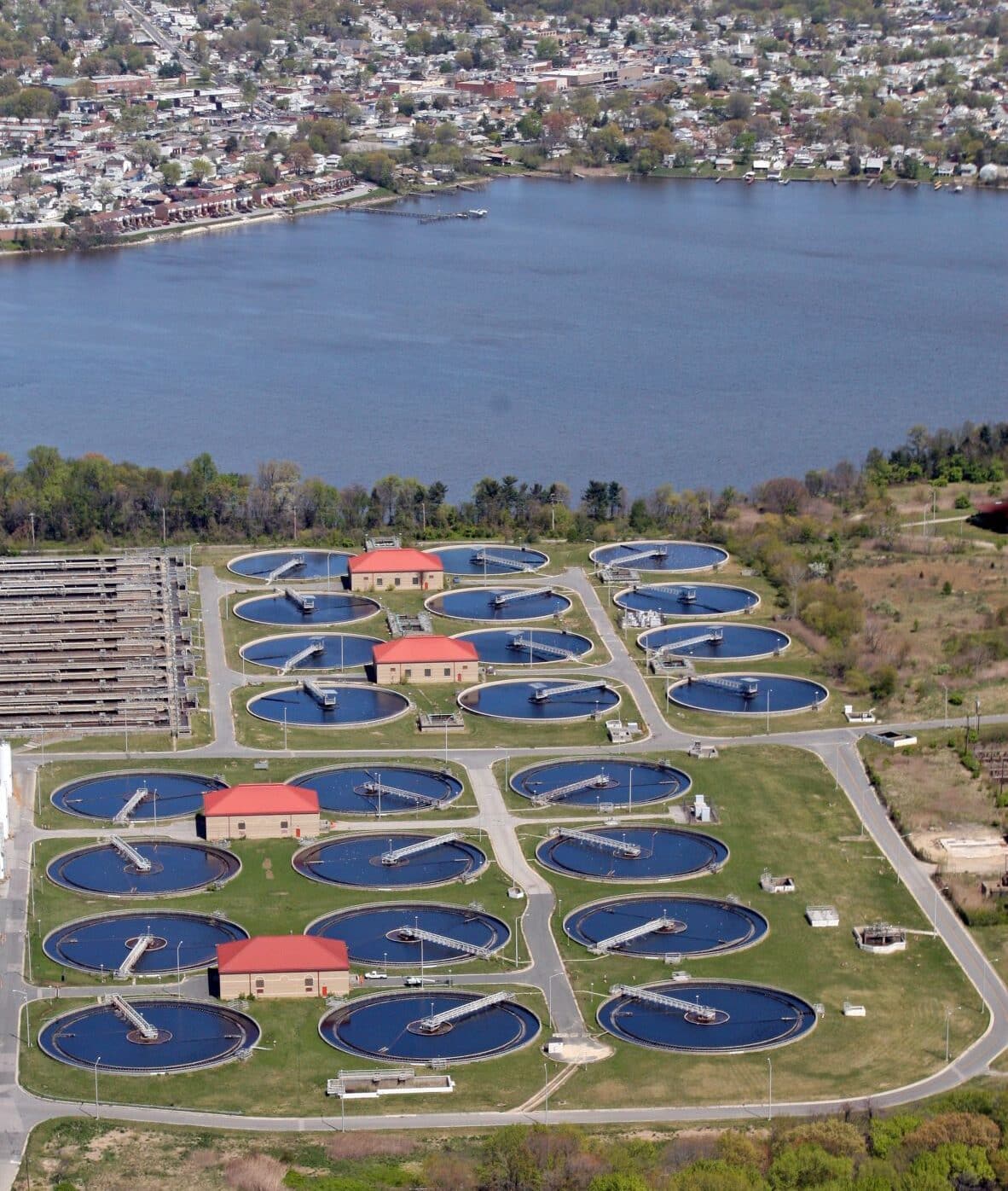
Blue Water Baltimore conducts routine sampling for Enterococcus bacteria (fecal indicator bacteria), and they have occasionally found spikes in bacteria counts related to runoff events from heavy rainfall. During routine 2021 sampling, consistently high bacteria readings were found from water collected at the outflow of an effluent pipe from the Patapsco River Wastewater Treatment Plant upriver of the Key Bridge. The high counts exceeded treatment plant permit limits of 35 most probable number (MPN) Enterococcus/100mL for the monthly geometric mean. The results were not associated with the timing of runoff events from heavy rainfall. This discovery was passed on to the Maryland Department of the Environment (MDE), which led to an in-depth investigation for the Patapsco Wastewater Treatment Plant. The inspector found violations with both operation and maintenance deficiencies, including equipment malfunction, out-of-order equipment, shortages in staffing, and improper sampling and handling procedures of toxic wastewater contaminants.
In December 2021, Blue Water Baltimore filed a federal Clean Water Act lawsuit against Baltimore City. Discharge Monitoring Reports (DMRs)were used from January 2017 through September 2021 to demonstrate that permit limits were violated at both the Patapsco and Back River Wastewater Treatment Plants. Further, the plants failed to comply with requirements for testing and reporting of PCBs, toxic chemical testing, mitigation of FOGs (fats, oils, and grease), minimization of environmental impacts, managing within effluent limits, monitoring and reporting, maintaining facility operations staff and filing and updated wastewater capacity management plan. MDE then filed a lawsuit in January 2022 requesting a state enforcement action. This lawsuit was based on violation of state and federal water pollution statutes, civil penalties, and unauthorized discharge of pollutants at both wastewater treatment plants. In March 2022, MDE requested that the Maryland Environmental Service (MES) take a supervisory role at the Back River Wastewater Treatment Plant.
These actions have led to the Back River Restoration Committee contacting Blue Water Baltimore to find out ways the residents of that area can help. A community science pilot program was created by BWB in 2022. Two sampling events were held to collect data on Enterococcus bacteria levels. 7 of 25 samples (28%) collected on May 26th failed the requirements for the code of Maryland regulations for protecting the recreational use of the waterway. 34 of 43 samples (79%) collected on September 2nd failed the requirements. Recreating in waterways with Enterococcus bacteria levels above 130 MPN/100 mL carries a higher risk of getting sick from waterborne pathogens. The sampling results provide a snapshot in time of the water quality. As you can see from the maps below, bacteria levels in the Back River vary by sampling date and location.
Based on continuous testing by Blue Water Baltimore the bacteria and pollution levels are improving near both wastewater treatment plants, and they are trending in the right direction. As of October 12th 2022, a ruling by the judge in the BWB federal case ordered Baltimore City to submit status updates monthly to the court demonstrating that continual progress is being made towards lower bacteria levels and decreased levels of pollution at both sites. Blue Water Baltimore continues to engage and increase citizen involvement with water collection events to detect bacteria levels. In addition, they are working towards a legally-binding agreement for wastewater treatment plants to become compliant.
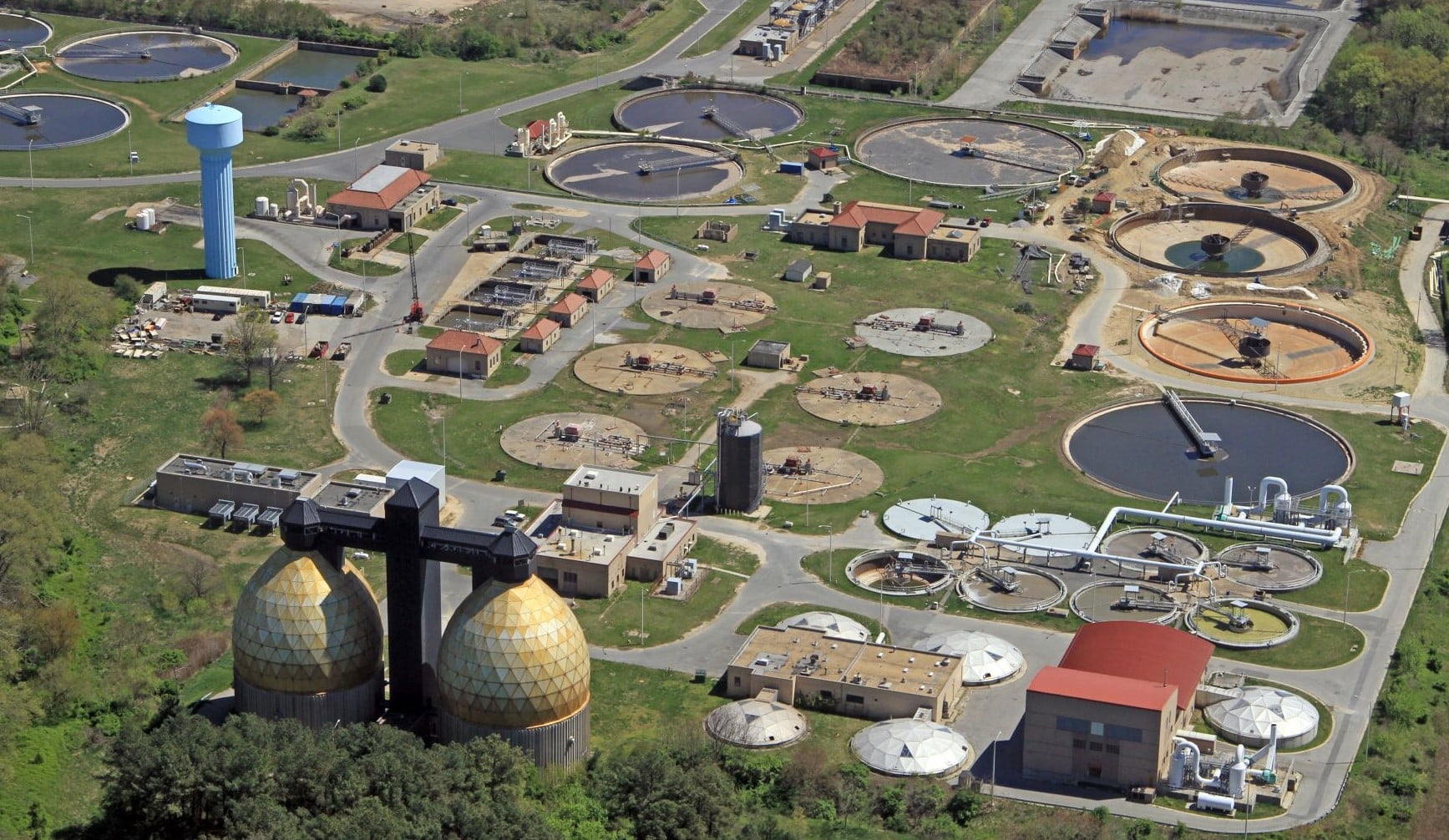

Written by: Maria Burke
Local Data Guides Stream Restoration Decisions
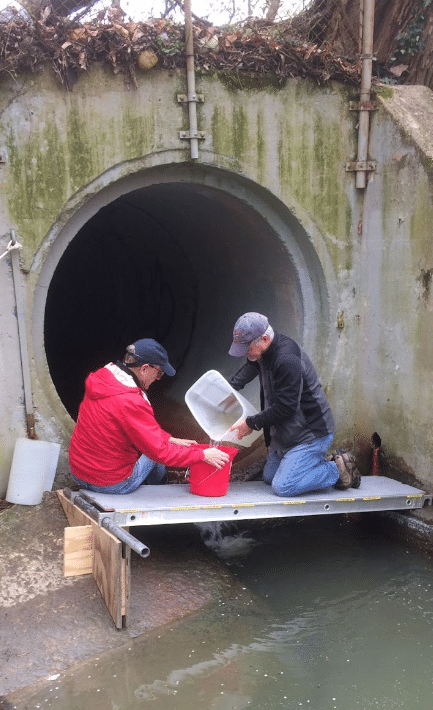
Taylor Run is a stream located in Alexandria, Virginia that flows into the Potomac River. In 2019, the City of Alexandria determined that stream restorations of three local streams (Lucky Run, Strawberry Run, and Taylor Run) should be conducted in order to earn nutrient reduction credits through the Chesapeake Bay Program in order to meet the TMDL 40% plan. The City applied for a grant through the Virginia Department of Environmental Quality Stormwater Local Assistance Fund, and calculated their nutrient reduction credits using the CBP Expert Panel Removal Rates. However, those removal rates are based on soil samples which were collected from eleven streams in Pennsylvania and not samples specific to Alexandria. The differences in topography, environment, soil, and land use of these samples prompted a response from the community, the city advisory board, and the Environmental Policy Commission (EPC) for the necessity of a local study. The City Council made the decision to pause the restoration on Taylor Run and Strawberry Run until further studies had been completed.
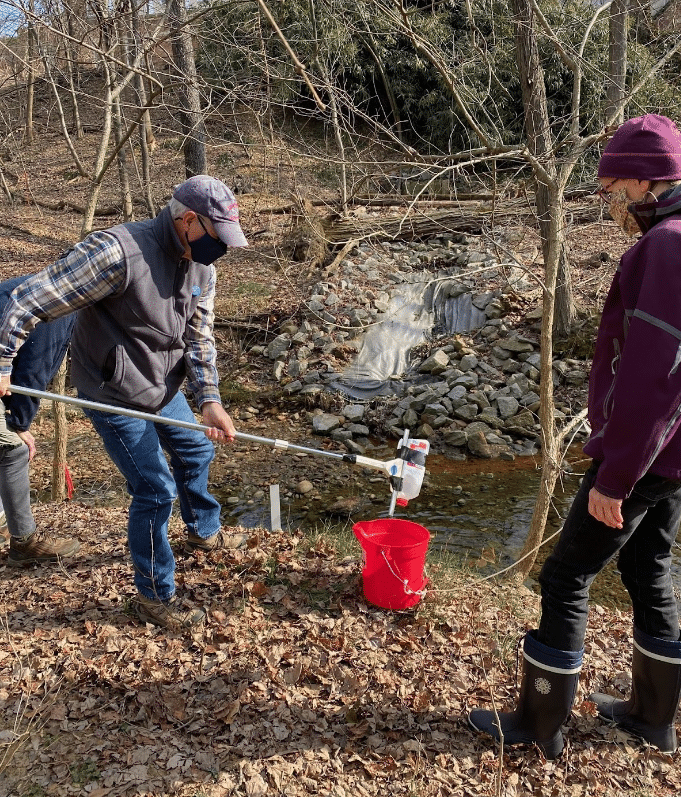
Taylor Run was chosen as one of the stream restoration sites due to severe erosion in some areas and evidence of downcutting and widening in other areas, however, evidence of poor local water quality was not determined. The proposed stream restoration project included excavating an area 1900 ft x 75 ft, cutting down over 250 trees, and raising the stream bed 3-7 ft, and according to experts, would destroy existing plant and animal communities and threaten 25 rare species in the wetland area. The North Ridge Citizens’ Association (NRCA) received a $5,000 grant from the Virginia Department of Environmental Quality to conduct a stream study for Taylor Run analyzing nutrients (TN, TP, TSS) and sediment flows in order to determine the water quality impact from Taylor Run into the Potomac River and the Bay. These data were coupled with support from the Alliance for the Chesapeake Bay’s RiverTrends, which provided the monitoring equipment, analysis, and training for additional stream indicators. Several of these indicators contribute to the CMC and are Tier 2 level data.
The study undertaken by the NRCA consisted of water quality measurements and samples taken at the upstream and downstream sites of the 1900 ft. stream twice a month between March and October 2021. According to Bill Gillespie, the monitoring team took the measurements a step further. “You can have a load of nitrogen or phosphorus in the stream banks, but if it never (or only rarely) gets in the water, you won’t get the nutrient reduction credits based on stream bank sampling and erosion estimates.” The samples were taken at both high and low water and consisted of the following measurements: air and water “temperature, pH, conductivity, turbidity, and dissolved oxygen, and lab grab samples. The grab samples were then taken to a certified lab to determine Total Nitrogen (TN), Total Phosphorus (TP), and Total Suspended Sediment (TSS) measurements, which were found to be 20-30% of the levels of the Pennsylvania stream data. The NRCA presented their data to the City Council. In addition to the graphs of the measurements taken for TN, TP, and TSS during their study, recommendations for alternatives for nutrient reduction credits for the city were presented. By restoring Lucky Run and through RiverRenew Nutrient Reduction Credits and tree planting projects, Alexandria can more than satisfy their nutrient credits. As for next steps, the community, EPC, and the City Council are currently in mediation to develop plans for Taylor Run and Strawberry Run. Best management practices such as stormwater retention ponds, bioswales, and rain gardens as well as implementing erosion control measures in Chinquapin Park (upstream from Taylor Run) would reduce stormwater volume and velocity, as well as improve water quality in Taylor Run.
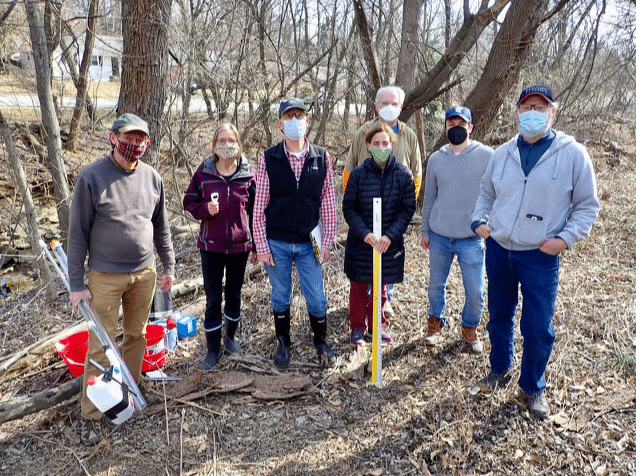

Written by: Maria Burke
Treatment Facility Under Construction to Address Toxic Discharge Detection
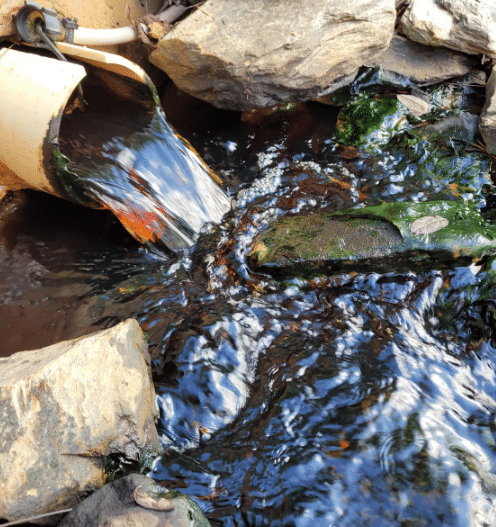
Kreutz Creek is part of a small watershed in York County, Pennsylvania. It flows into the Susquehanna River, which is the largest tributary into the Chesapeake Bay. Cindy Pizziketti, a Penn State Extension Master Watershed Steward, is a resident who lives in the Kreutz Creek area and is passionate about the importance of keeping streams clean. She believes that we need to be the “Lorax for the creeks.” At the end of 2018, she began conducting monthly monitoring in Kreutz Creek with the Alliance for Aquatic Resource Monitoring (ALLARM) at Dickinson College.
ALLARM’s Stream Team collects baseline water quality data on a monthly basis that examines the relationship between watershed health, geology, and land use. The monthly monitoring includes measurements of temperature, water clarity, conductivity, pH, nitrate-nitrogen levels, stage, and visual site characteristics. Additional data may also be collected on macroinvertebrates. They currently have approximately 130 volunteers which monitor over 75 sites in ten Pennsylvania counties. These data are then used locally for municipalities and counties, or for state, regional, and/or federal purposes. All data collected is made available through the Chesapeake Data Explorer, and ALLARM has made data summaries and a recording of an interpretation of the Stream Team dataset accessible. ALLARM partners with the Lower and Middle Susquehanna Riverkeeper Associations and Penn State Extension’s Master Watershed Stewards to continue the success of Stream Team. ALLARM also receives funding support from the Campbell Foundation for the project.
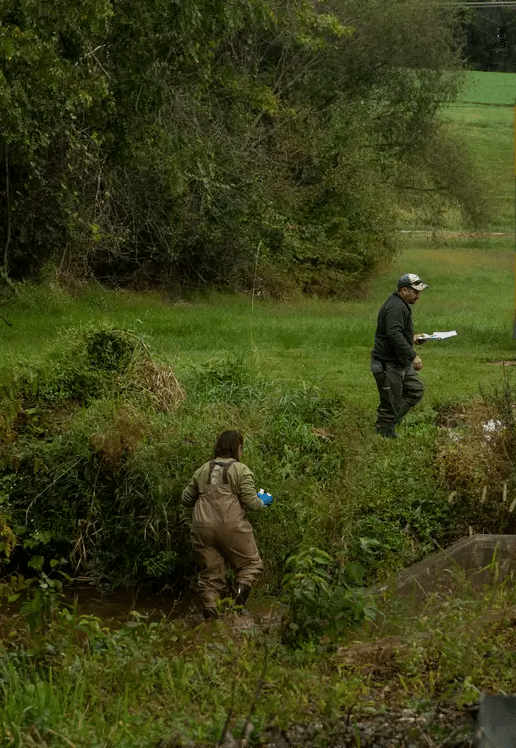
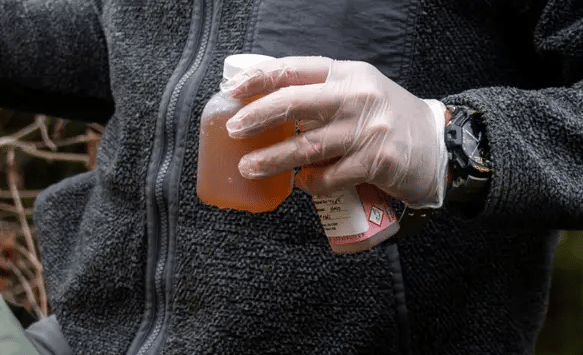
In addition to reporting spikes in nitrate-nitrogen values, as a frequent visitor to Kreutz Creek, Cindy is able to note visual site changes. During monthly monitoring in August 2019, Cindy discovered brownish-red discharge in the creek. It was determined that the discharge source was an effluent pipe from Modern Landfill, dumping leachate into the creek. This discharge could be observed miles downstream in both the stream bed and on the banks of the creek. Cindy contacted Ted Evgeniadis, Executive Director of the Lower Susquehanna Riverkeeper Association. Ted started taking additional heavy metal and PFAS samples at 5 sites above, at, and below the effluent pipe outfall in early 2020. Test results showed numerous chemical compounds were in the water samples associated with the discharge, including boron, nitrates, manganese, uranium and lithium traces, and PFAS levels that were well above EPA standards.
Modern Landfill, which is managed by Republic Services, has been informed of their violation of these EPA standards. The landfill is currently constructing a $23 million water treatment facility due to open in mid-2023 in order to achieve compliance with effluent standards. Both Cindy and Ted are continuing to monitor the stream in hopes of seeing water quality improvements in Kreutz Creek due to the water treatment facility implementation.

Written by: Maria Burke
Business Corrects Practices in Response to Monitoring Results
Jordan’s Branch is a small tributary that feeds into the Chickahominy River located on the border of Henrico County and the City of Richmond in Virginia. Jordan’s Branch starts near Libbie Mill, a highly urbanized shopping and residential area in Henrico County, then flows into Bryan Park, one of Richmond’s historical parks and frequently used for recreation, before reaching the Chickahominy River. In 2017, a business owner in the Libbie Mill area emailed the Henrico County Department of Public Works (DPW) as he was concerned about the water runoff from the turfed dog runs from Impawsible Pups, the business next door. This water left a green slime and smelled strongly of urine and fecal waste. He made a request to have the water tested in order to determine whether or not there was a hazard posed to his employees in addition to an environmental impact due to runoff into a nearby storm drain. Bacteria tests for fecal coliform completed in-house with Henrico DPW were negative on a few occasions. Recommendations were made by the DPW for the manager of Impawsible Pups to investigate their drainage pipes.
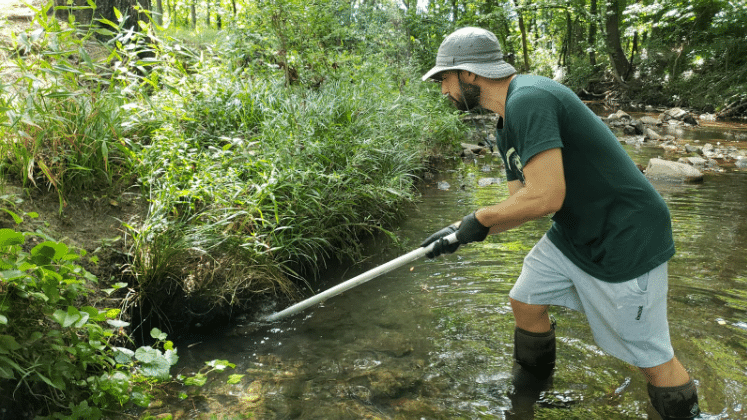
In 2019, the stagnant water in the stormwater retention area at Libbie Mill gave off strong odors, prompting an investigation. Initially, the positive Escherichia (E. coli) tests were attributed to the fecal matter of wildlife. After an investigation of the storm sewer in Jordan’s Branch near Libbie Mill, it was determined that the source of the E. coli was Impawsible Pups. Their property drained through the storm sewer and the stormwater pond. In addition, there was an illegal connection and they were performing illicit discharges when cleaning the turfed dog runs. Samples were analyzed at Enviro Compliance Laboratories, and the resulting levels were astronomically high. In Virginia, bacteria levels over 235 colony forming units (CFU)/100mL are cause for concern. The sample collected upstream of the MS4 discharge pipe measured 46 CFU/100 mL; and two samples taken at the discharge pipe measured 14,000 CFU/100 mL and 38,000 CFU/mL. A formal letter was sent to Impawsible Pups to immediately cease discharge of the contaminated water from the outdoor dog run pursuant to County code. The request for proposed resolutions was acknowledged by the owner and changes were put into place. Among these changes were a change in cleaning and disinfection protocol, staff education on proper procedures, the installation of a vacuum system, and a follow-up on the drainage.
In mid-2021, Stacey Sovick, a conservation specialist with the Henricopolis Soil and Water Conservation District, as well as the program coordinator of the Henrico Area Water Quality Samplers (HAWQS), noticed E. coli levels increasing over a two-month period from samples collected through their HAWQS volunteer monitoring program. This prompted Henrico County to take additional lab analyzed samples from six different locations above and below the dog kennel. Results from Enviro Compliance Laboratories confirmed Impawsible Pups as the source of the contamination again, with bacteria measuring 2800 CFU/100 mL below the kennel outfall. Deana Miller, an environmental program specialist with the Henrico County DPW, contacted Impawsible Pups with the information and inquired about their current protocol and whether anything had changed. The owner acknowledged that a turnover in their workforce had occurred, and he agreed to retrain his staff and closely monitor the practices and protocols to ensure proper implementation.
Since that time, HAWQS has continued monitoring this area and has not seen E.coli levels that are concerning, but their volunteers will continue frequent testing in order to ensure the levels remain low. Ongoing participation of volunteers in the HAWQS program as well as other programs in the Chesapeake Bay Watershed is vital to ensuring that water quality issues are addressed and resolved.
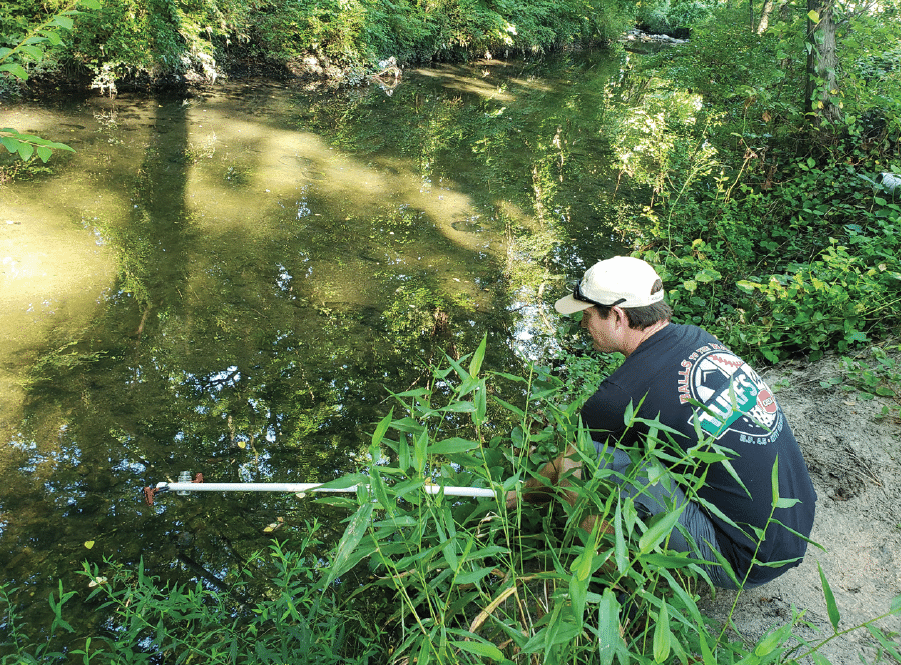
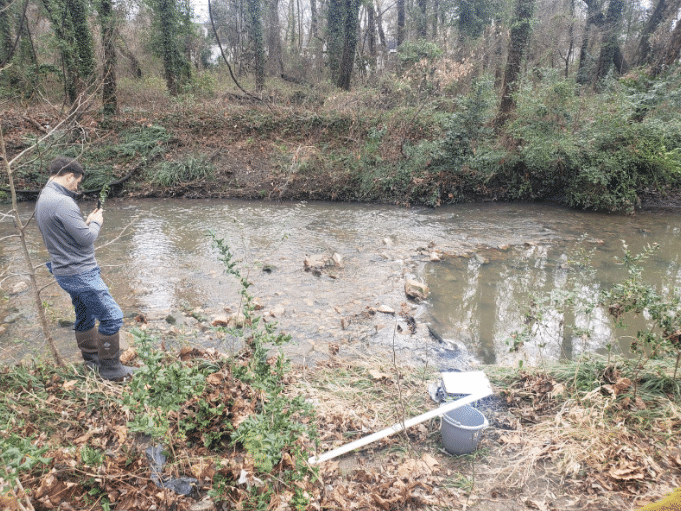

Written by: Matthew Kierce
A Community’s Response to Water Quality and Health Concerns
A tributary of Limestone Branch that flows through the JK Black Oak Wildlife Sanctuary near Lucketts, Virginia, and less than four miles upstream from the Potomac River, became a focal point for environmental and public health concerns in 2021. Loudoun Wildlife Conservancy volunteers, through their diligent monitoring, discovered alarming levels of E. coli in the stream, raising questions about the impact on the local community’s health and the environment.
The Izaak Walton League of America certifies volunteers to conduct benthic macroinvertebrate surveys and identify the macroinvertebrate community to order level. In May 2021, certified monitors conducted baseline benthic macroinvertebrate surveys at two sites on the tributary located approximately a quarter mile apart on the JK Black Oak property. Monitoring benthic macroinvertebrates is crucial for assessing water quality because different organisms have varying levels of tolerance to pollution, thus their presence or absence provides valuable indicators of the environmental health of water bodies.
The survey at the upstream site resulted in a stream health score of 10 out of 12, indicating acceptable ecological conditions. The downstream site received a score of 5 out of 12, indicating unacceptable ecological conditions.

Concerned about the drastic difference in scores at sites so close to each other, volunteers walked the stream and discovered a neighboring wastewater treatment facility in between the two sites. Their findings prompted Loudoun Wildlife to collaborate with Friends of the Shenandoah River and the Potomac Riverkeeper Network for further bacterial testing, revealing high concentrations of E. coli originating from this wastewater treatment facility.
The discovery was particularly troubling due to the karst topography of the area, a landscape shaped by the dissolution of soluble rocks, creating features like sinkholes, caves, and underground rivers. This meant that the surface water quality directly influenced the groundwater. This was a significant issue for Lucketts residents, who relied on well water sourced from these streams.
In response to these findings, Loudoun Wildlife Conservancy secured a $41,432 grant from the Tides Foundation, funded by Google Data Centers Grants Fund, in 2022 for a project titled “Securing Clean Drinking Water for the Lucketts Community.” The project’s objectives included assessing the extent of E. coli contamination in local streams, educating the community about water contamination, and providing resources and solutions for potential drinking water contamination.
Volunteers undertook extensive testing, including 29 rounds of E. coli sampling at six stream sites and two wastewater treatment discharge pipes, as well as benthic macroinvertebrate surveys over the course of the year. The results were concerning, with over 70% of bacteria samples exceeding Virginia Department of Environmental Quality’s (VA DEQ) safety thresholds for recreational water use. Notably, the wastewater treatment discharge samples frequently surpassed VA DEQ’s permissible limits, sometimes with values over 192 times the permit limit.
Loudoun Wildlife worked with VA DEQ throughout this project to share E. coli data and observational data about sewage solid sediment buildup in the receiving tributary of Limestone Branch. VA DEQ conducted follow-up investigations, the results of which were shared with the United States Environmental Protection Agency (US EPA). In March 2023, the US EPA mandated that the owner of the malfunctioning wastewater treatment facility address the issues.
To raise awareness, Loudoun Wildlife organized a town hall meeting, developed a dedicated project webpage, and collaborated with local organizations for outreach. The town hall meeting at Lucketts Community Center featured experts discussing E. coli, well and septic maintenance, and the relationship between karst topography and water quality. Additional outreach materials provided to the community also stressed the importance of how individuals can help reduce E. coli levels in streams by picking up after pets, installing livestock exclusion fencing, and maintaining proper septic systems.
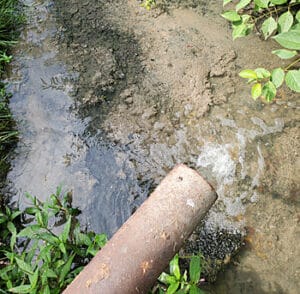
The project significantly aided local residents, particularly in underserved minority communities. Loudoun Wildlife partnered with a local church and nonprofit to reach out to Hispanic families in the area about their water quality. During an interpreter-assisted community meeting, it was revealed that families were spending up to $3,600 a year on bottled water, out of concern that their tap water was unsafe for drinking or cooking.
Using translated documents and the assistance of a native-speaking community leader, Loudoun Wildlife volunteers provided comprehensive drinking water assessments to 17 Hispanic families consisting of 65 individuals. The assessments showed that their drinking water was safe but had a high mineral content, making it “very hard.” While hard water is not harmful to health, it can affect the taste and smell.
Although translated summaries of the results were provided, the families did not trust the results and continued using bottled water. Loudoun Wildlife then purchased and helped install high-quality countertop water filtration systems and electronic water descalers to address the taste and smell issues. The families then felt safe consuming the treated water and agreed to stop purchasing bottled water. These filtration systems and descalers will save the communities nearly $250,000 over four years.
The Limestone Branch tributary case study highlights the critical role of community engagement and water monitoring in addressing environmental and public health concerns. It demonstrates how data-driven action can lead to meaningful improvements in both environmental conditions and the quality of life for local residents.
